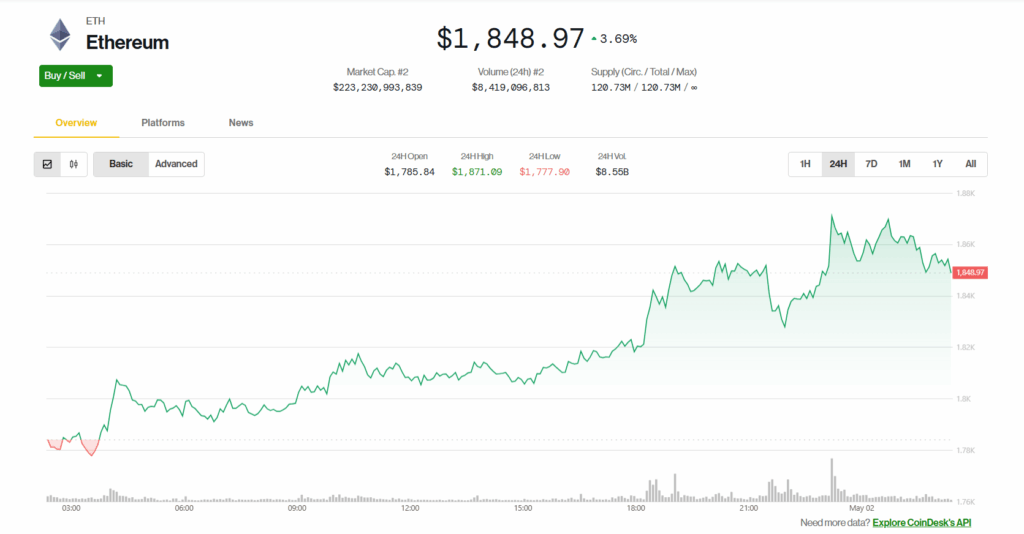- Bitcoin rebounded 16% in April despite a market-wide selloff triggered by Trump’s global tariff rollout.
- Canada’s pro-crypto Conservatives lost to crypto-skeptic Liberals, who must now form a minority government.
- Ethereum’s RWA tokenization value jumped 20% to $6.2B, reinforcing its lead in institutional blockchain adoption.
April 2025 turned out to be anything but boring for global markets and crypto watchers alike. With President Trump throwing a curveball of new tariffs, the economic ripple effects spread fast — even crossing borders into Canada’s election landscape. Let’s break down what happened and what it could mean moving forward.
Trump’s Tariffs Shake Markets, Bitcoin Holds Ground
April 2 was dubbed “Liberation Day” by Trump — and it sent markets into a tailspin. The president hit 185 countries with retaliatory tariffs, and it wasn’t pretty: the Dow crashed by 2,200 points, and the S&P 500 dropped nearly 6%. Investors panicked. Trillions evaporated.
Bitcoin dipped, too, sliding 9% by April 8. But in typical crypto fashion, it bounced back and ended the month up over 16%, sitting around $94,700. Unlike equities, BTC shook off the panic faster and signaled a shift in investor behavior as they look for alternative hedges amid economic uncertainty.
Canada Votes: Liberals Win, But It’s Complicated
Up north, Canada held a pivotal election on April 28. The pro-crypto Conservative Party, led by Pierre Poilievre, ended up losing to the more crypto-cautious Liberals under PM Mark Carney. Still, it wasn’t a landslide — the Liberals landed 169 seats, just shy of a majority.
Carney, a former central banker, has long been skeptical about crypto. He’s said private tokens should have safeguards equal to commercial bank money, but he’s also shown support for digital money’s potential — especially when backed by central banks. A minority government might mean slow-moving crypto legislation for now.
Ethereum Leads RWA Boom
Meanwhile, Ethereum had a solid month on the real-world assets (RWA) front. Tokenization projects boomed, pushing the value of RWAs on Ethereum to $6.2 billion — up 20% in just a month.
Big names like BlackRock are all-in on Ethereum for tokenized assets, citing its speed, security, and developer support. It’s becoming the go-to chain for asset digitization like real estate, gold, carbon credits — you name it.
US States Push New Crypto Laws
While federal regulators drag their feet, US states are moving forward. Texas proposed a blockchain pilot for government systems, and Georgia introduced a bill to promote crypto education in schools. Pretty wild to think Web3 might make its way into middle school classrooms soon.
Arizona’s governor took a mixed approach — vetoed one bill that would’ve expanded crypto programs but signed off on a new law protecting home crypto miners from local bans. If you’ve got rigs humming in your garage, Arizona just became your best friend.
Stablecoins Quietly Surge by $4 Billion
Amid market drama, stablecoins saw quiet but steady growth. The sector added $4 billion in April, according to CoinGlass, helped by favorable legislation and increasing use as safe havens.
The STABLE Act in Congress gained traction, and the SEC dropped its inquiry into PayPal’s PYUSD token. With inflation fears and rate jitters still in play, stablecoins are gaining popularity among cautious investors looking for shelter without exiting crypto entirely.

Final Thoughts
Trump’s tariff tantrum has created a lot of noise — and a lot of pain — across markets. But in crypto land, some sectors are quietly thriving. Ethereum’s becoming the RWA king, stablecoins are growing fast, and even with political shakeups, the wheels of adoption are still turning.
If there’s one lesson from April? Keep your eyes on the long game — because things can turn fast.
Would you like me to generate bullet points or a summary for this too?

















